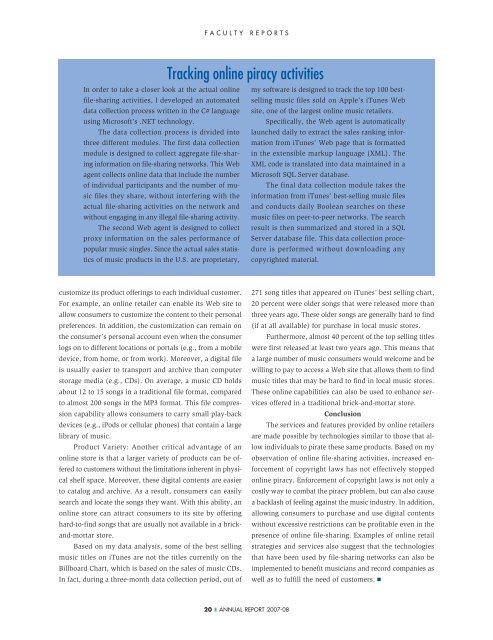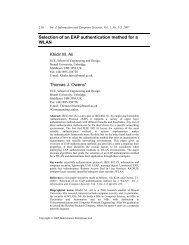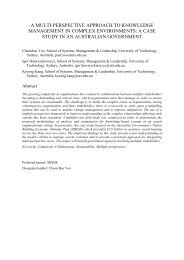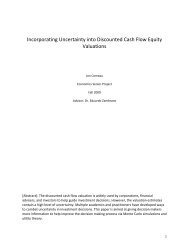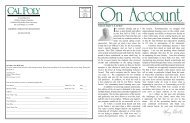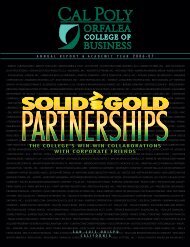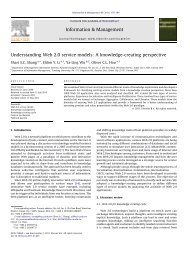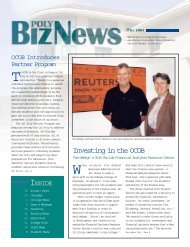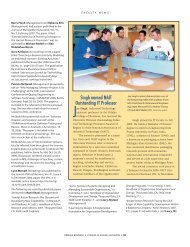OCOB Ann Rep 07-08 - Orfalea College of Business - Cal Poly San ...
OCOB Ann Rep 07-08 - Orfalea College of Business - Cal Poly San ...
OCOB Ann Rep 07-08 - Orfalea College of Business - Cal Poly San ...
You also want an ePaper? Increase the reach of your titles
YUMPU automatically turns print PDFs into web optimized ePapers that Google loves.
FACULTY REPORTSTracking online piracy activitiesIn order to take a closer look at the actual online my s<strong>of</strong>tware is designed to track the top 100 bestsellingmusic files sold on Apple’s iTunes Webfile-sharing activities, I developed an automateddata collection process written in the C# language site, one <strong>of</strong> the largest online music retailers.using Micros<strong>of</strong>t’s .NET technology.Specifically, the Web agent is automaticallyThe data collection process is divided into launched daily to extract the sales ranking informationfrom iTunes’ Web page that is formattedthree different modules. The first data collectionmodule is designed to collect aggregate file-sharinginformation on file-sharing networks. This Web XML code is translated into data maintained in ain the extensible markup language (XML). Theagent collects online data that include the number Micros<strong>of</strong>t SQL Server database.<strong>of</strong> individual participants and the number <strong>of</strong> musicfiles they share, without interfering with the information from iTunes’ best-selling music filesThe final data collection module takes theactual file-sharing activities on the network and and conducts daily Boolean searches on thesewithout engaging in any illegal file-sharing activity. music files on peer-to-peer networks. The searchThe second Web agent is designed to collect result is then summarized and stored in a SQLproxy information on the sales performance <strong>of</strong> Server database file. This data collection procedureis performed without downloading anypopular music singles. Since the actual sales statistics<strong>of</strong> music products in the U.S. are proprietary, copyrighted material.customize its product <strong>of</strong>ferings to each individual customer.For example, an online retailer can enable its Web site toallow consumers to customize the content to their personalpreferences. In addition, the customization can remain onthe consumer’s personal account even when the consumerlogs on to different locations or portals (e.g., from a mobiledevice, from home, or from work). Moreover, a digital fileis usually easier to transport and archive than computerstorage media (e.g., CDs). On average, a music CD holdsabout 12 to 15 songs in a traditional file format, comparedto almost 200 songs in the MP3 format. This file compressioncapability allows consumers to carry small play-backdevices (e.g., iPods or cellular phones) that contain a largelibrary <strong>of</strong> music.Product Variety: Another critical advantage <strong>of</strong> anonline store is that a larger variety <strong>of</strong> products can be <strong>of</strong>feredto customers without the limitations inherent in physicalshelf space. Moreover, these digital contents are easierto catalog and archive. As a result, consumers can easilysearch and locate the songs they want. With this ability, anonline store can attract consumers to its site by <strong>of</strong>feringhard-to-find songs that are usually not available in a brickand-mortarstore.Based on my data analysis, some <strong>of</strong> the best sellingmusic titles on iTunes are not the titles currently on theBillboard Chart, which is based on the sales <strong>of</strong> music CDs.In fact, during a three-month data collection period, out <strong>of</strong>271 song titles that appeared on iTunes’ best selling chart,20 percent were older songs that were released more thanthree years ago. These older songs are generally hard to find(if at all available) for purchase in local music stores.Furthermore, almost 40 percent <strong>of</strong> the top selling titleswere first released at least two years ago. This means thata large number <strong>of</strong> music consumers would welcome and bewilling to pay to access a Web site that allows them to findmusic titles that may be hard to find in local music stores.These online capabilities can also be used to enhance services<strong>of</strong>fered in a traditional brick-and-mortar store.ConclusionThe services and features provided by online retailersare made possible by technologies similar to those that allowindividuals to pirate these same products. Based on myobservation <strong>of</strong> online file-sharing activities, increased enforcement<strong>of</strong> copyright laws has not effectively stoppedonline piracy. Enforcement <strong>of</strong> copyright laws is not only acostly way to combat the piracy problem, but can also causea backlash <strong>of</strong> feeling against the music industry. In addition,allowing consumers to purchase and use digital contentswithout excessive restrictions can be pr<strong>of</strong>itable even in thepresence <strong>of</strong> online file-sharing. Examples <strong>of</strong> online retailstrategies and services also suggest that the technologiesthat have been used by file-sharing networks can also beimplemented to benefit musicians and record companies aswell as to fulfill the need <strong>of</strong> customers. ■20 ❚ ANNUAL REPORT 20<strong>07</strong>-<strong>08</strong>


